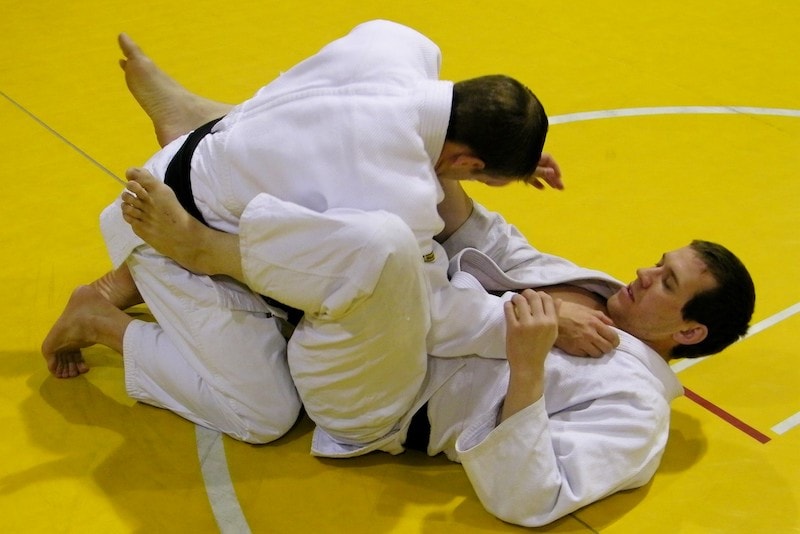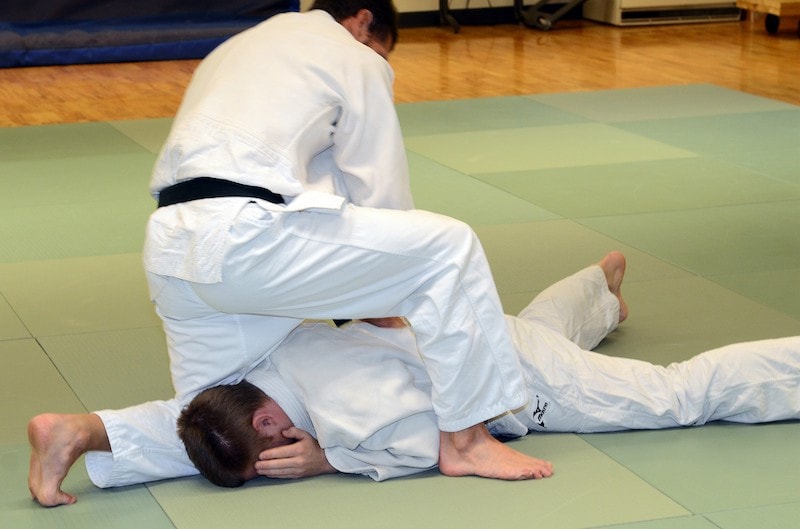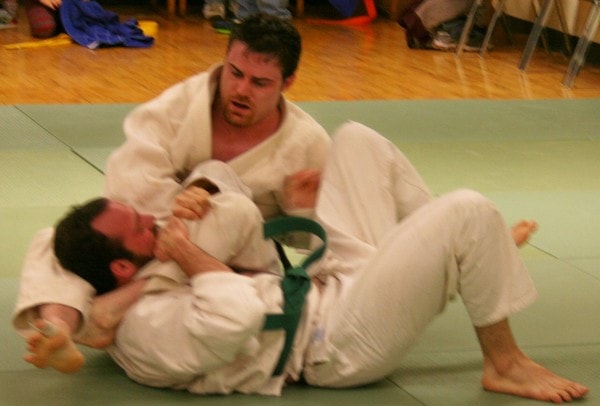For anyone who's watched Mixed Martial Arts (MMA), and that probably includes many of the people reading this, the phrase "ground fighting" is well-known. It's a good description of what takes place in either an MMA fight or in a self-defense situation. The term "ground fighting" is actually a generic one and for the sake of clarity, needs to be parsed out and examined.
Ground Fighting and Ground Grappling
Ground fighting encompasses both grappling and striking. The "ground and pound" seen in MMA as well as in street fights is an example of this. Getting an opponent down on the ground and onto his back in order to hit him is something that most every schoolboy has done or seen in a school yard fight. This is a literal and practical application of ground fighting; fighting someone on the ground. But there's more to fighting on the ground than simply getting an adversary onto his back and beating him.
What is seen in modern wrestling and grappling sports is not so much ground fighting as it is ground grappling. Hitting and kicking an opponent while engaged in grappling on the mat aren't permitted in wrestling, judo, sambo, Brazilian Jiu-jitsu (BJJ), or any other modern wrestling-based sports. While it may appear to be splitting hairs, it's necessary to understand the difference between fighting on the ground and grappling on the ground.
Western and Asian Perspectives on Grappling
In the western tradition of fighting or wrestling, getting an opponent onto his back is considered as having the advantage. So much so, that in both ancient and modern Olympic wrestling, a wrestler who is lying flat on his back on the mat for a few seconds loses the contest by a pin. In reality, being belly-up is much like a turtle who has been placed on his back-he's vulnerable. This has been the prevailing attitude in western wrestling and combat for centuries. However, this hasn't been the case in the Asian combat or fighting systems, especially the martial arts developed in Japan.
From the Japanese perspective, being on your back doesn't necessarily mean that you are losing. Let me explain. In the feudal martial arts of Japan, there was little, if any, grappling as we think of it today. The bujin (warriors) in Japan didn't view the martial arts as a sport. These fighting systems are called martial arts for a good reason; they were the military arts of war. Ideally, getting an adversary down onto the ground in what is called "utsubuse," or "belly-down" position gave the opponent a clear advantage. The fighter who was prone and flat on the ground afforded his opponent the opportunity to finish him off with his spear, sword, knife or club. Lying face down with his face in the dirt and an opponent positioned above him was the worst place to be for a warrior in a fight on the battlefield.
Fast forward this use of utsubuse to today. This belly-down control is used by law enforcement officers when handcuffing an assailant. Getting the perpetrator onto his front in a prone position with his face looking at the floor is the most efficient and effective way of controlling and getting the handcuffs on him. Likewise, "getting the back" of an opponent in a judo, BJJ, sambo or MMA match provides a grappler an ideal opportunity for both control and applying a submission technique.
It wasn't until the development of Kodokan Judo in 1882, that the Japanese fighting systems embraced the idea of pinning or controlling an opponent with him lying on his back and belly-up. This belly-up position is called "aomuke" in Japanese martial arts. The tactic of pinning an opponent who is belly-up came into Japanese judo from western wrestling in the late 19th Century.
Newaza and the Guard
Fighting from a supine position while on the mat or ground has its roots in the Japanese jujutsu systems that developed in the late 19th Century, most notably the judo developed by Professor Jigoro Kano. Later, in the early 20th Century, a branch of judo that placed emphasis on ground grappling called Kosen judo gained popularity in Japan. The concept of "newaza" or techniques applied from a supine position was emerging and gaining popularity. Later, in the 1920s, Mitsuo Maeda, a judo man who toured the world as a professional wrestler, introduced judo to the Gracie family in Brazil. From this start, the exponents of Brazilian Jiu-jitsu focused on ground grappling with a particular emphasis on fighting from the supine position.
As described in the book published in 1973 called "Newaza of Judo" by Sumiyuki Kotani, Yoshimi Osawa and Yuichi Hirose, fighting from or fighting against an opponent in the supine position is called "newaza no semekata" or "attacking forms of supine techniques." What this means is that there was a methodical approach to the development of both tactics and techniques from this position. Independently of this, the exponents of BJJ were developing their own methodology of this grappling position. With the popularity of MMA, most people refer to newaza as the "guard."
What we now see in today's martial arts that emphasize grappling is a diverse combination of technical skills, controlling positions, submission and pinning techniques as well as transition techniques from standing to the ground. If you asked the typical sports fan in the 1960s how he knew who was losing, he would most likely say "the guy on his back." This was mainly because of the popularity of professional wrestling where the victor pinned his opponent on his back with shoulders touching the mat for three seconds. This isn't the case anymore. With the popularity of MMA, fighting from a supine position (newaza or guard) is recognized as being just as effective and fighting from any other position.
This was a significant development in the evolution of combat sports. A grappler was now able to apply submission techniques or pinning techniques from any position, whether on the back or not. This technical transformation led to a wider variety of tactical applications of controlling an opponent as well, and because of this, every combat sport or martial art has benefitted.

Here is one of the many ways to fight from a supine position. Both the bottom grappler and the top grappler are working for an advantage.

The bottom grappler is lying belly-down and vulnerable in the utsubuse position.

The bottom grappler is lying face-up and vulnerable in the aomuke position.
The above is an original article by Steve Scott, author of The Triangle Hold Encyclopedia, Pub Date May 2022, YMAA Publication Center, ISBN 9781594396496.




